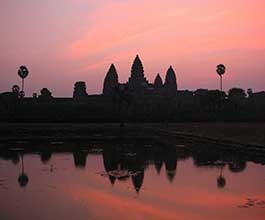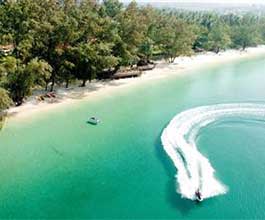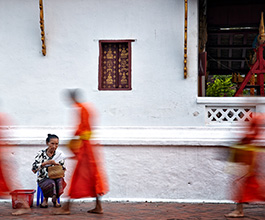OverviewOften referred to as the 'Kingdom of Wonder,' this beguiling country is located in South East Asia, bordered by Thailand, Laos and Vietnam. Cambodians are known for their warm hospitality and their natural friendliness. The national language is Khmer, though English is spoken fairly widely throughout. Getting ThereGetting to Cambodia is simple, as a host of daily flights from nearby hubs arrive into both Siem Reap and Phnom Penh. Most flights from Europe and North America connect first in Bangkok, Seoul, Hong Kong, Singapore or Taipei. |
CurrencyRiel is the currency of Cambodia but US dollars are widely used and most prices will be in US$. When receiving change from a dollar, the cents will be returned to you in Riel. Note that even slightly torn US dollar bills will not be accepted. Visa & MasterCard are accepted in most hotels, and some restaurants. ATMs are very common in every city and town. HolidayPublic holidays in Cambodia center around four main themes; traditional farming celebrations, Buddhist festivals, the Royal Family and those recognizing independence from France and the Khmer Rouge. Arguably the most important festival is the Khmer New Year (April 14-16), which sees Cambodian families returning to their hometowns around the country. It marks the end of the harvest, and food features heavily in the festivities. Families will often place small shrines outside their houses, with candles and incense burning all day. The ritual washing of Buddha statues, the elderly and oneself is also important, intended to bring luck for the rest of the year. The most visually impressive festival is the Water Festival (October or November), celebrating the ancient Cambodian navy of King Jayavarman VII (builder of Ta Prohm, Angkor Thom and Bayon), as well as the change in flow of the Tonle River. Boat races are held throughout the country, with the largest being in Phnom Penh, but Siem Reap´s, passing through the centre of town is a fantastic spectacle and highly recommended. |
Meet An Expert
Not yet sure about where to travel? Talk to one of our travel advisors. We live in the region, and will give expert, up-to-date travel advice. Talk To Us |

VisaCitizens of most countries can apply for a visa online or get one on arrival in Cambodia. Citizens of the following countries should arrange a visa before travel, from their nearest Cambodian Embassy: Afghanistan, Algeria, Saudi Arabia, Bangladesh, Iran, Iraq, Pakistan, Sri Lanka, Sudan, and Nigeria. 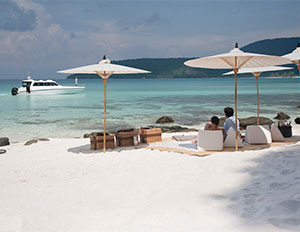
|
e-VisaThe Cambodian government has a simple online application for an e-visa. It is a straightforward procedure and your visa is delivered electronically to you after around three days and costs $30 plus a $7 administration fee (total $37).  CLICK HERE TO APPLY ONLINE CLICK HERE TO APPLY ONLINEFOR YOUR TOURIST VISA Visa On ArrivalYou can obtain a Visa on arrival at your port of entry. Fill in the arrival documents which you will receive in on the plane or at the border and provide one passport-size photograph. The fee is currently US$30 paid in cash and is valid for 30 days. You can extend the visa once you are here if necessary. |
Meet An Expert
Not yet sure about where to travel? Talk to one of our travel advisors. We live in the region, and will give expert, up-to-date travel advice. Talk To Us |
|
Cambodian food may not have garnered the same fame as neighbouring Vietnam or Thailand, but there are subtleties to the dishes that set it apart. South East Asian cuisine is famous for the intense flavours and liberal use of chilli, while Cambodian classics such as lok-lak and amok have caught the attention of chefs due to their reputation for wonderfully subtle and aromatic attributes. The fried spiders and bugs for which Cambodian cuisine is also famous offer another dynamic not found in Thai or Viet dishes. |
 As a still developing country, being careful about what one eats and drinks here is important. While tap water in Phnom Penh and Siem Reap is treated and safe, aging pipes ensures that bottled water is the safest option, and the only one in rural settings. In restaurants catering to tourists all food preparation is undertaken using bottled or treated water, and hygiene is of a high standard.Ice throughout the country is produced using treated water and should be safe. Drinks other than water are widely available - from freshly made sugar cane juice, to coconuts and fruit shakes to the ubiquitous Angkor Beer. Cambodian ProduceTweak your itinerary to take in some of the best produce that Cambodia has to offer, from the eclectic to the mainstream. Learn how rice paper rolls or the fragrant prahokfishpaste is made in Battambang, visit the famous Kampot pepper farms on the south coast (and the local salt farms as well as the not-so-famous Durian farms nearby), go fishing yourself or see how a variety of snakes, fish and shellfish are captured for the plate. More important is to sample some of the local produce: while the fried tarantulas of Skuon are not to everybody's taste, seafood lovers will adore the crab of Kep (perhaps cooked with fresh Kampot peppercorns), and numerous roadside snacks and treats cater to all possible tastes.
|
Meet An Expert
Not yet sure about where to travel? Talk to one of our travel advisors. We live in the region, and will give expert, up-to-date travel advice. Talk To Us |
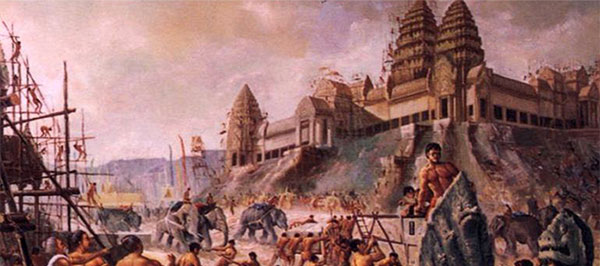 The earliest evidence of human existence in Cambodia are stone tools dating back to 7000BC. Numerous archaeological sites throughout northern Cambodia have provided examples of pottery and tools as proof of continuous habitation of the region.

|
Meet An Expert
Not yet sure about where to travel? Talk to one of our travel advisors. We live in the region, and will give expert, up-to-date travel advice. Talk To Us |


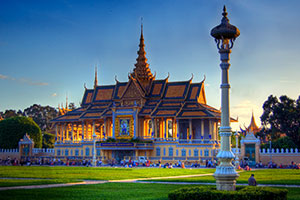



 Under French control, Cambodia, was largely neglected, with the French focused on collecting taxes,and bringing few educational or infrastructure improvements to the country.
Under French control, Cambodia, was largely neglected, with the French focused on collecting taxes,and bringing few educational or infrastructure improvements to the country.
 Sihanouk's rule had grown increasingly repressive, and in 1965 he allowed North Vietnamese troops to use the eastern part of the country as part of the Ho Chi Minh trail. By 1967 this had had a destabilizing effect on the region, and American and South Vietnamese troops were invited to enter Cambodia to engage the North Vietnamese. This was accompanied by U.S. aerial bombing in the east, killing untold thousands of Cambodians and fuelling hatred of the USA and those in government supported by them. Lon Nol, who supported the American actions faced growing resistance from Cambodia's communist guerrilla movement, the Khmer Rouge.
Sihanouk's rule had grown increasingly repressive, and in 1965 he allowed North Vietnamese troops to use the eastern part of the country as part of the Ho Chi Minh trail. By 1967 this had had a destabilizing effect on the region, and American and South Vietnamese troops were invited to enter Cambodia to engage the North Vietnamese. This was accompanied by U.S. aerial bombing in the east, killing untold thousands of Cambodians and fuelling hatred of the USA and those in government supported by them. Lon Nol, who supported the American actions faced growing resistance from Cambodia's communist guerrilla movement, the Khmer Rouge.
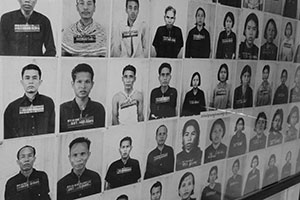 Renaming the country Democratic Kampuchea, the Khmer Rouge embarked on an extreme Maoist version of communist theory, seekingto return the country to an agrarian utopia free from foreign interference - year zero. This began with the "evacuation" of Phnom Penh, two days after its capture. The entire population of Phnom Penh was forced to return to their ancestral villages, and the destruction of the trappings of modernity ensued - cars, refrigerators, etc., were piled in the streets by the largely illiterate Khmer Rouge cadres.
Renaming the country Democratic Kampuchea, the Khmer Rouge embarked on an extreme Maoist version of communist theory, seekingto return the country to an agrarian utopia free from foreign interference - year zero. This began with the "evacuation" of Phnom Penh, two days after its capture. The entire population of Phnom Penh was forced to return to their ancestral villages, and the destruction of the trappings of modernity ensued - cars, refrigerators, etc., were piled in the streets by the largely illiterate Khmer Rouge cadres.
 In 1991, the United Nations was given a mandate to implement and enforce a ceasefire between the warring parties. The United Nations Transitional Authority in Cambodia (UNTAC), and its peacekeeping operations in 1992-1993 marked the first time the UN administered a sovereign state. Its primary success was the 1993 election, which saw 90% of eligible voters elect Prince Ranariddh's FUNCINPEC Party to head a coalition government, and write a new constitution, making Cambodia a multiparty liberal democracy with a constitutional monarchy.
In 1991, the United Nations was given a mandate to implement and enforce a ceasefire between the warring parties. The United Nations Transitional Authority in Cambodia (UNTAC), and its peacekeeping operations in 1992-1993 marked the first time the UN administered a sovereign state. Its primary success was the 1993 election, which saw 90% of eligible voters elect Prince Ranariddh's FUNCINPEC Party to head a coalition government, and write a new constitution, making Cambodia a multiparty liberal democracy with a constitutional monarchy.
